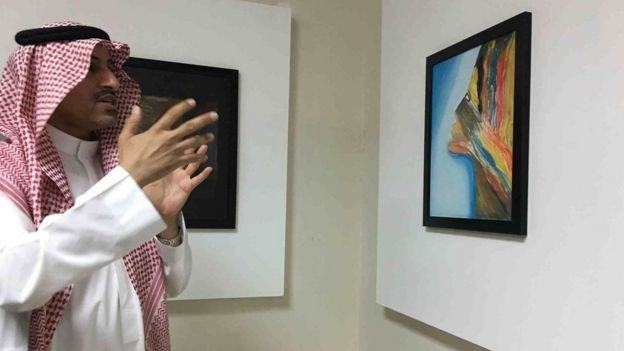Lined up against the wall of a tent, their backs against embroidered cushions, electronic tags around their ankles, the nine Yemeni al-Qaeda prisoners fidgeted nervously, folding and unfolding their hands.
Most of these men, who we were not allowed to photograph, have spent the last 15 years of their lives incarcerated in US military detention in Guantanamo Bay. The most recent arrived here in April.
They were picked up on the battlefield in Afghanistan between 2001 and 2007 and eventually released by the US to Saudi custody, on the understanding they would be deradicalised here before re-entering society as free men.
So what, I asked them this week, did they make of President Trump’s visit to Saudi Arabia and his speech on Islam and the need for religious tolerance which they watched on TV? There were smiles and knowing glances exchanged.
“I don’t know if he was being sincere,” said one, touching his chest. “I would have to check his heart to see if he was telling the truth!”

“There were many words,” said the oldest amongst them, his grey, wispy beard trailing down to his chest, “but we will judge him by his actions.”
Another made the point that there was now a different US administration in the White House from the one (George W Bush’s) that sent them to Guantanamo Bay.
It was of course, a somewhat unnatural encounter. The Yemeni returnees looked uncomfortable, having been shepherded into the tent to meet our delegation of Western academics and journalists, watched over by the Saudi staff.
Every one of them would have been all too aware that their words were being carefully monitored for any hints of violent intent. Their imminent release depended on it.
Even when that day comes, they will only be released into the city of Riyadh since their own country, Yemen, is in the grip of war and it would be all too easy for them to be swept back up into the waiting ranks of al-Qaeda in the Arabian Peninsula (AQAP).

The Saudi authorities are keen to show the world this rehab centre for jihadists, known officially as the Prince Mohammed Bin Nayef Centre for Counselling and Care.
Founded in 2004, following a series of devastating al-Qaeda attacks in Saudi Arabia, it is intended to be a halfway house between prison and open society.
Most of its inmates are Saudis, convicted under anti-terrorist laws. It prepares ex-convicts for life on the outside and tries to purge them of any violent ideas.
So does it work? Mostly.
There is certainly no other such rehab centre anywhere in the world that is attempting this kind of psychological detoxification on such a large scale.
More than 3,300 inmates have “graduated” from the centre since 2005, according to the staff, including 123 who have been in Guantanamo Bay. The success rate, they said, is 80% with the remaining 20% returning to violence. (A similar scheme I visited in Yemen in 2003 had a significantly lower success rate).
Inmates spend a minimum of three months at the centre before being assessed to see if they ready for release, Their overall programme is divided into three parts:
- A counselling phase, which takes place while they are still in prison and before they arrive at the centre
- Rehabilitation (“ta’heel” in Arabic) comprising cognitive behaviour programmes, art, culture, religious and sports activities
- After care. This continues after their release into society
“Welcome to the oasis of wisdom,” said Dr Hamid Al-Shayri, a sociologist from King Saud University. “This is where we try to steer them away from their deviant path so they no longer present a danger to society.”
He said his staff sit with the inmates for several hours a day, but added: “It’s not an easy task to get people to stop hating society and their families.”

Art therapy plays a big role in their rehabilitation, according to their art teacher, Dr Badr Al-Razin. He told me that when they first arrive, many of the ex-convicts want to paint crude, violent images, often in red, but over time their images soften and become gentler.
Religious scholars are on hand at all times, men with a profound knowledge of Islam, who try to use this to explain why the aims and actions of violent jihadists are “haram” (forbidden).
So how, we asked the Yemeni returnees from Guantanamo Bay, do they feel about re-entering society after all this time?
“We have changed,” said the oldest one. “We consider ourselves as new individuals now, thanks to this place.
“Sure, we hated the people who mistreated us in Guantanamo Bay but through the programmes here we were able to overcome these feelings. My worry now is that people in the community will not accept us.
“And meanwhile the world has changed so much since we’ve been away, we may not recognise it.”


